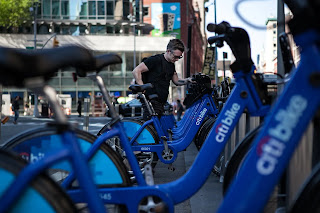Cities that have Bike to Work Days or Weeks usually hold them in the middle of Spring. The reason, I believe, is that it's easier to entice people to give up four wheels and one gas pedal for two wheels and two pedals on a day when it's neither "too" hot nor "too" cold.
Now, I agree that if people pedal rather than drive to work a couple of days a week or a few months out of the year, it's at least something of a victory. However, bike commuting is seen as a real transportation alternative mainly in places where people ride bikes year-round. And not all of those places have balmy winters: think of Amsterdam, Copenhagen or Paris, where I recently took a trip.
Another such place, I imagine, is Fort Collins, Colorado. I have been to the Centennial State only in the summer, but I hear that winters can be brutal. So, I would think that any committed bicycle commuter--or any committed cyclist in general--is prepared to pedal through all sorts of meteorological perils.
Also, I would expect that the daily rides, for some, don't involve a trip to the office or other workplace. Some, of course, might be ride to school, but others are headed to the store, the park or "wherever."
It is that last category of riders, as much as the time of year, that makes Fort Collins' Winter Bike To Work (or Wherever) Day interesting, and possibly unique. This year's Day will kick off at 7 am on 10 February, a week from this Friday. Local businesses, schools and other organizations will run an array of free breakfast stations, some of which will double as bike tech or warming spots. They will remain open until 9:30 am, when a ceremony involving remarks by the mayor, a concert by Crispy Watkins and recognition for bicycle-friendly businesses.

A cyclist in Fort Collins' Winter Bike To Work Day in 2019. (Photo by Bethany Baker for The Coloradan.
As much as I want to encourage more people to pedal to work or school, I think a true bicycling culture develops when people ride "wherever," year-round. It seems that Fort Collins is trying to encourage that.





.jpg)


















